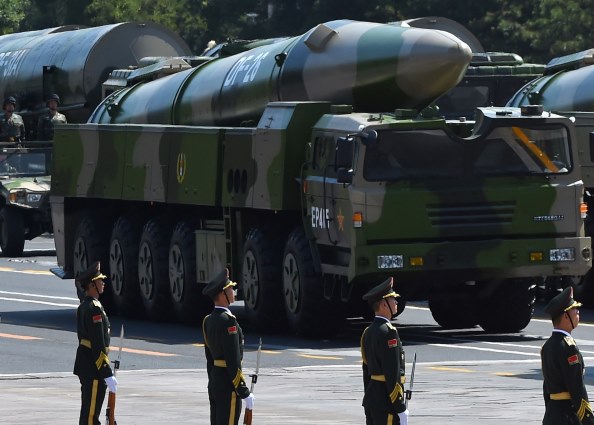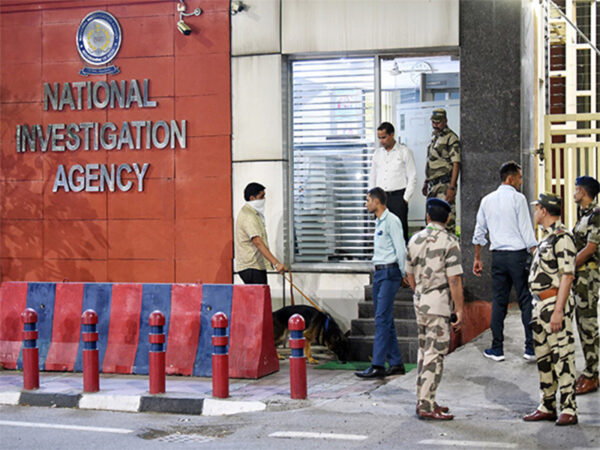
China’s Nuclear Arsenal Growing In Tech, Capability
China’s nuclear forces, under the aegis of the People’s Liberation Army Rocket Force (PLARF), are nowhere as large as those of the USA or Russia, but the inventory is significantly growing and modernizing.
New missiles such as DF-41 and DF-31AG intercontinental ballistic missiles (ICBM) were paraded in Beijing in October 2019, demonstrating the forward strides that the PLARF is making.
An annual report from the Bulletin of the Atomic Scientists, titled Chinese Nuclear Forces 2020 and authored by Hans Kristensen and Matt Korda, discussed the state of play in the PLARF. It claimed, “China is continuing the nuclear weapons modernization program that it initiated in the 1980s and increased in the 1990s and 2000s, fielding more types and greater numbers of nuclear weapons than ever before.”
It is impossible to say how many nuclear weapons China actually has, but Kristensen and Korda offer their best estimate in the report. They claimed, “We estimate that China has a produced a stockpile of approximately 350 nuclear warheads, of which roughly 272 are for delivery by more than 240 operational land-based ballistic missiles, 48 sea-based ballistic missiles and 20 nuclear gravity bombs assigned to bombers.” The report continued, “The remaining 78 warheads are intended to arm additional land- and sea-based missiles that are in the process of being fielded.”
This figure of 350 is up significantly from the estimated 290 listed in the 2019 edition of the report from the Bulletin of the Atomic Scientists.
Significantly, these figures vary from those issued in the US Department of Defense’s (DoD) annual report on Chinese military power. The authors acknowledged: “This estimate is higher than the ‘low-200’ warheads reported by the Pentagon in its 2020 report to Congress; however, the Pentagon’s estimate only refers to ‘operational’ Chinese nuclear warheads, and therefore presumably excludes warheads that are attributed to newer weapons still in development. It is also possible that the Pentagon’s estimate does not include dormant bomber weapons. Taking those categories into account, the Pentagon’s estimate is roughly in line with our own.”
Some commentators over the past decade have warned that China has hundreds, some even thousands, of nuclear weapons. The Bulletin of the Atomic Sciences confirms that the more conservative estimates have invariably been correct, “while the higher estimates and projections for significant increases have been incorrect”.
Although US intelligence community projections have predicted greatly increased numbers of nuclear missiles for the PLA, these have generally proved inaccurate. For instance, a Defense Intelligence Agency (DIA) estimate from 1999 predicted China might have 460 nuclear weapons by 2020. This obviously did not eventuate.
That makes it more difficult to accept with any degree of certainty current estimates. The DIA’s 2019 report predicted, for example, “Over the next decade, China will at least double the size of its nuclear stockpile.”
The new report highlighted the fielding of the dual-capable DF-26 intermediate-range ballistic missile (IRBM), as well as the aforementioned DF-31AG and DF-41 ICBMs. All are mounted on enormous road-mobile transporter-erector-launcher (TEL) vehicles, which gives them greater survivability in the event of any conflict. The DF-41 is capable of carrying multiple independently targetable re-entry vehicles (MIRV), much like the older liquid-fueled and silo-based DF-5B also in PLARF service.
The report included a table with all known nuclear weapons fielded by the PLARF. The land-based missiles are: the DF-4 ICBM (x6 launchers, and probably gradually retiring); DF-5A ICBM (x10 launchers); DF-5B ICBM (x10 launchers and with five warheads per missile); DF-21A/E medium-range ballistic missile (x40 launchers); DF-26 (100 launchers, of which 20 missiles have nuclear warheads); DF-31 ICBM (x6 launchers); DF-31A ICBM (x36 launchers); DF-31AG ICBM (x36 launchers); and DF-41 ICBM (x18 launchers with 54 warheads in total).
This gives a total of 244 land-based launchers and 204 warheads. Once those new missiles approaching introduction are added to the equation, the numbers increase to 280 launchers and 258 warheads from land-based assets.
The report listed the upgraded DF-5C ICBM too, which is supposed to be deployed in 2020. It is unclear what modifications it has over the DF-5B, for it has the same 13,000km range and carries MIRVs. Also listed as not yet becoming operational is the DF-17, where 18 launchers carrying missiles with hypersonic glide vehicles are to be formally fielded in 2021. It is not immediately clear who will operate the DF-17, but it could be 627 Brigade in Puning.
Two DF-41 brigades are thought to exist, one of which may be nearing operational capability. These are assumed to be 634 Brigade in Tongdao and 644 Brigade in Hanzhong. Furthermore, 662 Brigade in Luanchuan could be upgrading to the DF-41. Additional DF-41 TELs are in production, so we can expect more to be added. As it replaces the DF-5, the DF-41 could also be launched from silos and railcars. Indeed, several new silos have been constructed in the Jilintai training area in Inner Mongolia, and there is possibly silo construction for 662 Brigade in Henan Province.
The DF-26 is an interesting case. This years’ Pentagon report on China’s military listed 200 such weapons, but Kristensen and Korda take this to be a typographic error, as the US Indo-Pacific Command only estimates 100 DF-26s, plus this lower figure better corresponds to known base infrastructure. It is estimated that 20 of the 100 IRBMs possess a nuclear warhead, with the rest of them carrying conventional high-explosive payloads. The primacy of the older DF-21 family has been overtaken by the DF-26, and users, in order of conversion, are the PLARF’s 666 Brigade in Xinyang, 626 Brigade in Qingyuan, 625 Brigade in Jianshui, and 654 Brigade in Dengshahe.
China also has nuclear-tipped missiles assigned to its fleet of ballistic missile submarines (SSBN). The table in the report thus listed the 7,200km-range JL-2 submarine-launched ballistic missile (SLBM), with four submarines carrying 48 missiles (12 JL-2 missiles per boat), plus two more submarines and associated 24 missiles becoming operational next year.
In April this year, the PLA Navy (PLAN) actually debuted these two extra Type 094 SSBNs, and these give an added second-strike ability to China. These submarines are based at the Yulin base on Hainan Island on the periphery of the South China Sea.
Given that the Type 094 is a relatively noisy design, perhaps two orders of magnitude louder than the best American or Russian SSBNs, Beijing is now developing the Type 096 SSBN that will carry the newer JL-3 SLBM with potential 9,000km range. Production of the Type 094 will thus probably remain at six hulls, with the newer design to begin construction in the early 2020s. The PLAN could eventually have 8-10 SSBNs in service.
China has never confirmed that its SSBNs have conducted patrols with JL-2 SLBMs aboard, but potential adversaries must assume this is the case. A Reuters report last year revealed that the USA, Japan, Australia and the UK “are already attempting to track the movements of China’s missile submarines as if they are fully armed and on deterrence patrols”. Nonetheless, entrusting nuclear weapons to a submarine crew would represent a momentous step for the PLA.
Moving on to the PLA Air Force (PLAAF), the report mentioned, “China has recently reassigned a nuclear mission to its bombers and is developing an air-launched ballistic missile (ALBM) that might have nuclear capability.” The table lists 20 H-6N bomber aircraft, each of which can carry a single ALBM (called the CH-AS-X-13 by the USA).
The H-6N can be refueled in midair, and one of the first such operational units is thought to be the 106th Brigade at Neixiang Air Base in Henan Province. Once the ALBM is functional, it will complete China’s viable nuclear triad of delivery systems encompassing land, sea and air. China is currently developing the H-20 stealth bomber that will replace the H-6 family, and it will assuredly have a nuclear mission.
With the navy and air force inventory added to the aforementioned land-based missiles, China currently has312 launchers (soon to be 372) and 272 warheads (soon to be 350).
Obviously, the fielding of MIRVs will greatly enhance China’s nuclear stockpile. However, Kristensen and Korda believe that the number of MIRVed warheads per missile will be three to five only, rather than the ten that some analysts predict. Furthermore, some of their missile payload will be assigned to decoys and penetration aids. “This is because we believe that the purpose of the MIRV program is to ensure penetration of US missile defenses, rather than to maximize the warhead loading of the Chinese missile force.”
China’s use of hypersonic glide vehicles is another trend, as this will allow China to ensure the credibility of its retaliatory strike force as the US strengthens its missile defensive shield.
The US government thinks China could have 400-500 nuclear warheads by later this decade, apparently achieved “without new fissile material production”. The latter is an indication that China has not resumed production of fissile material for weapons.
Such predictions of nuclear weapon expansion also trigger speculation as to China’s intentions when it comes to nuclear posture. One wild claim from a Trump official was that “China no longer intends to field a minimal deterrent,” and is instead striving for “a form of nuclear parity with the United States and Russia”. Such exaggerations are more related to Trump’s efforts to include China in strategic nuclear arms control talks with Russia, than having any basis in reality.
China warned that it is “unrealistic to expect China to join the two countries in a negotiation aimed at nuclear arms reduction,” given that its inventory lags so far behind America’s and Russia’s.
China keeps most nuclear warheads at a central storage facility in the Qinling mountain range, but with others held at smaller regional centers. This is in keeping with its “low alert level” posture, enough to maintain a credible second-strike capability. Indeed, the Pentagon report states “China almost certainly keeps the majority of its nuclear force on a peacetime status – with separated launchers, missiles and warheads”.
Nonetheless, the PLARF “maintains a high degree of combat readiness,” according to the US military. Brigades regularly conduct combat readiness duties, assigning a battalion ready to launch and rotating to standby sites as often as every month.
A Chinese delegation explained last year, “In peacetime, the nuclear force is maintained at a moderate state of alert. In accordance with the principles of peacetime-wartime coordination, constant readiness and being prepared to fight at any time, China strengthens its combat readiness support to ensure effective response to war threats and emergencies. If the country faced a nuclear threat, the alert status would be raised and preparations for nuclear counterattack undertaken under the orders of the Central Military Commission to deter the enemy from using nuclear weapons against China. If the country were subjected to nuclear attack, it would mount a resolute counterattack against the enemy.”
The Pentagon warns that China may adopt a “launch-on-warning” posture in the future, whereby missiles already have nuclear warheads installed.
The PLARF is increasing its number of missile bases to accommodate the expansion in warheads/missiles. The number of brigades may have increased 35% in just the past three years. Indeed, the PLARF now probably has 40 brigades equipped with ballistic and cruise missiles, of which half could be nuclear-armed. (ANI)



